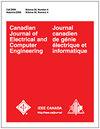Optimal Coordination of Double Primary Directional Overcurrent Relays Using a New Combinational BBO/DE Algorithm
IF 1.7
Q2 Engineering
Canadian Journal of Electrical and Computer Engineering-Revue Canadienne De Genie Electrique et Informatique
Pub Date : 2019-07-23
DOI:10.1109/CJECE.2018.2802461
引用次数: 20
Abstract
The optimal relay coordination (ORC) problem for directional overcurrent relays (DOCRs) has been solved by many conventional and modern optimization algorithms. All these studies were based on the common assumption that all DOCRs are numerical, digital “hardware-based,” static, or electromechanical. Unfortunately, the transition between these technologies does not happen instantaneously, so protection engineers could see different models of these protective relays in some real electric power systems. Moreover, when old electromechanical, static, and digital relays are replaced with the latest state-of-the-art numerical relays, the older relays are kept as backup protective devices. Some called them “primary” and “local-backup” relays, whereas others called them “main-1” and “main-2” relays. The reason behind the second terminology is the chance that the old relays could act ahead of the numerical relays. In this paper, a realistic mathematical model of the ORC problem is formulated and solved using a new hybrid evolutionary algorithm. To judge whether this realistic ORC problem is completely/partially solvable or not, the IEEE 6-bus, 15-bus, and 42-bus test systems are simulated. The results prove that the technique is an effective tool to indicate which relay sets accept/do not accept this double primary relay strategy.基于BBO/DE组合算法的双初级方向过流继电器优化协调
定向过电流继电器(DOCR)的最优继电器协调(ORC)问题已经通过许多传统和现代的优化算法得到了解决。所有这些研究都基于一个共同的假设,即所有DOCR都是数字的、数字的“基于硬件的”、静态的或机电的。不幸的是,这些技术之间的转换并不是瞬间发生的,因此保护工程师可以在一些真实的电力系统中看到这些保护继电器的不同型号。此外,当旧的机电、静态和数字继电器被最新的最先进的数字继电器取代时,旧的继电器被保留为备用保护装置。一些人称它们为“主”和“本地备份”继电器,而另一些则称它们为“主要-1”和“主要-2”继电器。第二个术语背后的原因是旧继电器有可能先于数字继电器。本文建立了ORC问题的一个现实数学模型,并使用一种新的混合进化算法求解。为了判断这个现实的ORC问题是否完全/部分可解,对IEEE 6总线、15总线和42总线测试系统进行了仿真。结果证明,该技术是指示哪些继电器组接受/不接受这种双主继电器策略的有效工具。
本文章由计算机程序翻译,如有差异,请以英文原文为准。
求助全文
约1分钟内获得全文
求助全文
来源期刊

自引率
0.00%
发文量
27
期刊介绍:
The Canadian Journal of Electrical and Computer Engineering (ISSN-0840-8688), issued quarterly, has been publishing high-quality refereed scientific papers in all areas of electrical and computer engineering since 1976
 求助内容:
求助内容: 应助结果提醒方式:
应助结果提醒方式:


